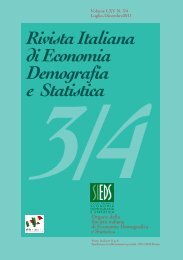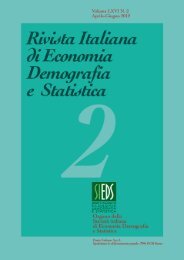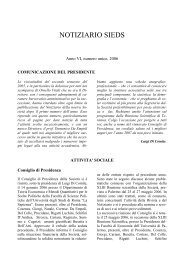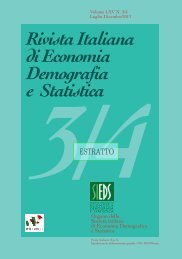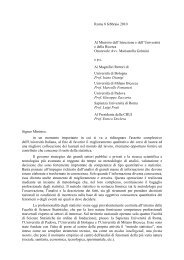rivista italiana di economia demografia e statistica - Sieds
rivista italiana di economia demografia e statistica - Sieds
rivista italiana di economia demografia e statistica - Sieds
Create successful ePaper yourself
Turn your PDF publications into a flip-book with our unique Google optimized e-Paper software.
128<br />
Volume LXIII nn. 3-4 – Luglio-Dicembre 2009<br />
che le analisi statistiche, per esempio le metodologie <strong>di</strong> sintesi, forniscono un<br />
ulteriore e fondamentale strumento nelle mani del policy maker.<br />
Riferimenti bibliografici<br />
Delvecchio F. 1995. Scale <strong>di</strong> Misura e In<strong>di</strong>catori Sociali. Cacucci E<strong>di</strong>tore, Bari.<br />
Giu<strong>di</strong>ci P., Avrini F. 2002. Modelli statistici per la costruzione <strong>di</strong> in<strong>di</strong>catori della qualità<br />
della vita: aspetti metodologici, Rivista <strong>di</strong> <strong>statistica</strong> ufficiale, n. 1, pp 61-80, Franco Angeli,<br />
Roma.<br />
Mazziotta M., Pareto A. 2007. Un in<strong>di</strong>catore sintetico <strong>di</strong> dotazione infrastrutturale: il<br />
metodo delle penalità per coefficiente <strong>di</strong> variazione, Atti della XXVIII Conferenza Italiana<br />
<strong>di</strong> Scienze Regionali, AISRe, Bolzano.<br />
Osterle A. 2002. Evaluating Equity in Social Policy. A Framework for Comparative<br />
Analysis. Vienna University of Economics and Business Administration, Austria, SAGE<br />
Publication, London.<br />
Scamuzzi S. 1990. Modelli <strong>di</strong> Equità, tra in<strong>di</strong>vidui, classi, generazioni. Il Mulino, Bologna.<br />
Sen A. 1986. Scelta, benessere, equità. Il Mulino, Bologna.<br />
Rawls J. 2005. A Theory Of Justice. Harvard University Press.<br />
Muraro G., Rey M. 1996. Ineguaglianza e re<strong>di</strong>stribuzione, Società <strong>italiana</strong> <strong>di</strong> <strong>economia</strong><br />
pubblica, Economia e finanza pubblica, Franco Angeli, Milano.<br />
SUMMARY<br />
The aim of this work is to define and to measure the social equity both from a<br />
theoretical point of view and from a <strong>statistica</strong>l point of view. The approach is<br />
inter<strong>di</strong>sciplinary: it is considered the sociological theory, in order to find<br />
precursory concepts from the classic sociology stu<strong>di</strong>es, methodological aspects, in<br />
order to define a precise model of empirical research, and <strong>statistica</strong>l measures in<br />
order to synthesize the phenomenon. The domain is the Europe of 27 member<br />
countries. It is a secondary analysis of data in which the source is the Eurostat<br />
database where the set of in<strong>di</strong>cators is standar<strong>di</strong>zed and harmonized at European<br />
level for the study of the “con<strong>di</strong>tion of life”. There is a special emphasis on the<br />
strategies of synthesis of these in<strong>di</strong>cators, since the aim is also to compare <strong>di</strong>fferent<br />
models of aggregation (composite in<strong>di</strong>cators) in order to verify the consistency of<br />
results and the vali<strong>di</strong>ty of the in<strong>di</strong>cators chosen.<br />
____________________________<br />
Matteo MAZZIOTTA, Ricercatore Istat<br />
Adriano PARETO, Ricercatore Istat<br />
Valentina TALUCCI, Dottoranda Università “La Sapienza” <strong>di</strong> Roma



